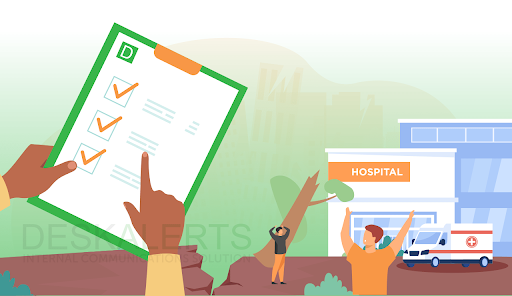Safeguarding Healthcare Facilities: Preparing Hospitals for Natural Disasters

In recent years, natural disasters have become more frequent around the world. Healthcare organizations in the United States may be affected by coastal storms or wildfires. They could also face droughts, flooding, and freezing. Your hospital’s facilities and staff may be affected by a natural catastrophe. Prepare for natural disasters in advance. They can be unpredictable and powerful.
Your hospital must know how to prepare your staff and facility for a disaster. Your hospital may be required to care for patients and provide shelter to the local community. Continue reading to learn more!
How natural disasters affect hospitals
Hospitals are affected by different types of natural disasters. Your hospital should be prepared for the following effects:
You will not be able to get the water and electricity you need if your hospital loses its power. In a natural catastrophe, hospitals face the challenge of losing power. This can make it difficult for them to function. Even if you have a hospital generator, the generator is likely old and in the basement. This puts them at risk of flooding.
Loss of infrastructure
Your hospital’s infrastructure and electronic records may be destroyed in a natural catastrophe.
Negative impact of the supply chain
Other facilities within your region may also experience power loss during a disaster, disrupting the supply chain.
Shortage of workers
A natural disaster can also lead to a staff shortage in your hospital. Staff may be unable to work because of illness, injury or lack of transportation.
Patients
Your hospital’s patient population may increase dramatically if a natural catastrophe causes injury or illness.
Relocation of Care
You may have to move your patients’ care to another location in a natural catastrophe. It can be a complex process; sometimes, relocating patients to a different location may only work if that alternate location is well-equipped for the sudden influx.
It is essential to prepare for such events. A hospital is often a haven of safety for the people of a community during a catastrophe.
What natural disasters can you prepare for?
Prepare your hospital for common natural disasters. Your location can influence which natural disasters will impact you more. A hospital in the Pacific Northwest might need to be prepared for wildfires and hurricanes, whereas a hospital in the Midwest would need to be ready for tornadoes or flooding. Natural disasters can be divided into three main categories:
- Climate disasters include wildfires and extreme temperatures.
- Storms, such as hurricanes and tornadoes
- Floods and mudslides are examples of hydrological disasters.
Wildfires
Wildfires are capable of causing significant damage over weeks or months. A wildfire in the Pacific Northwest could cause toxic smoke to force thousands of residents out. You need a disaster plan if your hospital is in an area that wildfires could threaten.
- Hospital disaster plans for wildfires should include the following:
- The evacuation procedure.
- Communication with other hospitals in the area.
- Monitor your facility’s air quality to ensure your filtration system works.
Hurricanes
Hurricanes are incredibly destructive. They can cause wind damage, flooding, and power outages. Your hospital’s occupancy rate will increase dramatically after a hurricane strikes your area. Staff stress levels may also rise.
The danger persists even after a storm has ended. Hospitals may continue to see an influx of new patients days after the storm. Many communities and organizations do not prepare for hurricanes until after a storm.
Floods
Floods severely threaten the health and safety of the hospital staff and the people in the surrounding community. Your hospital may be damaged or have its access disrupted by a flood. Visit the website to find out more! You could lose:
- Infrastructure.
- Medical Supplies
- Hospital Furniture
- Installers of Lifeline systems.
- Medical equipment can be expensive.
- Plan for flooding. It can cause havoc for weeks, even months.
Tornadoes
During a storm, your hospital faces hazards such as flying objects, falling items, and powerful winds. Even after the tornado has passed, the remaining damage can cause injury. Although there is no way of preventing a tornado from happening, your hospital can still take steps to ensure the safety and security of its staff, patients, and facility.
How hospitals can prepare for natural disasters
Natural disasters are unpredictable and can cause great destruction. However, you can prepare your facility and its staff to be ready for an emergency before it happens. Prepare hospitals for natural disasters by following the steps listed below.
You should make sure that all documentation is accessible
Being organized will help your hospital be prepared for natural disasters. Your facility must be able to function effectively even in an emergency. Your staff should be able to access all the necessary tools, including documents and reporting tools.
In the event of a fire or flood, documents in your hospital could be lost or destroyed. You can reduce these risks using electronic tools to keep your documentation organized and accessible. In particular, you should safeguard policies and procedures that your facility is required to follow during emergencies.
Find out the top risks
Identify the most significant hazards in your facility to help you create effective plans for managing these risks. Your hospital’s risk profile will depend on its location. A disaster preparedness plan in Florida may be different from one in Oregon. While a Florida-based hospital might be preparing to face hurricanes and floods, a California-based hospital would be preparing to deal with wildfires and quakes.
You can prepare better for most scenarios by knowing what the top risks in your hospital are.
Prepare disaster plans
You can develop a better disaster plan once you’ve identified the most significant risks in your facility. Your disaster plan must include protocols and policies that your staff must follow in an emergency. Set a plan for communicating during a disaster, and include what you must do during recovery. Communicate your disaster plans with your staff so they know their roles.
Perform Drills
People may panic if they are not prepared for an emergency. To prevent panic and confusion, perform drills at your hospital. Your staff will be able to understand the evacuation process and how to transport your patients to alternative facilities by regularly conducting drills.
By implementing a protocol, you will also show your staff how prepared your facility is for an emergency. This will eliminate any confusion during the actual event.





